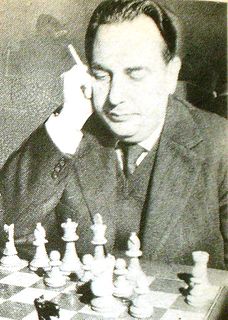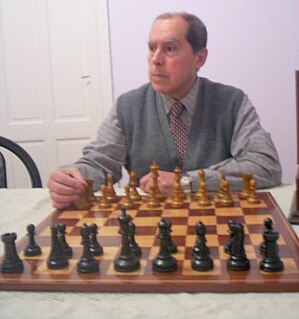Related Research Articles

Miguel Najdorf was a Polish-Argentinian chess grandmaster. Originally from Poland, he was in Argentina when World War II began in 1939, and he stayed and settled there. He was a leading world player in the 1940s and 1950s, and is also known for the Najdorf Variation, one of the most popular chess openings.
Markas (Marcos) Luckis was a Lithuanian–Argentine chess master.
Paul (Pablo) Michel was a German-Argentine chess master.
Samuel Schweber was an Argentine chess player.

Carlos Enrique Guimard was an Argentine chess Grandmaster. He was born in Santiago del Estero. His granddaughter Isabel Leonard is a celebrated mezzo-soprano.
René Letelier Martner was a Chilean chess player with the title of International Master. His finest international tournament win was in 1954, when he took the UNESCO tournament in Montevideo as clear first ahead of joint Ossip Bernstein and Miguel Najdorf, beating both in their individual game.
Jiří (Jorge) Pelikán was a Czech-Argentine chess master.
Enrique Alfredo KurtReinhardt was a German–Argentine chess master.
Bernardo Wexler was an Argentinian chess master.

Raúl Carlos Sanguineti was an Argentine chess Grandmaster. He won the Argentine Chess Championship seven times, in 1956, 1957, 1962, 1965, 1968, 1973 and 1974. Raúl Sanguineti played for Argentina in seven Chess Olympiads. He won two individual gold medals at Moscow 1956 and Varna 1962, and two team bronze medals at Munich 1958 and Varna 1962. In total, he represented his country in seven Olympiads with an aggregate of over 70 per cent. He played in the World Chess Championship Interzonals at Portorož 1958 and Biel 1976. Important tournament victories included São Paulo 1957, Bariloche 1960, Buenos Aires 1963, Punte del Este 1964, Buenos Aires Open 1968, Fortaleza Zonal 1975, Mar del Plata 1976, Buenos Aires 1977, and Santos Lugares 1977. During his competitive career, which ran from 1954 to 1977, he very rarely finished in the bottom half of the tournament table. In 1980 he won the Konex Award as one of the 5 best chess players of the decade in his country.
Walter Oswaldo Cruz was a Brazilian chess master.
Juan Traian Iliesco was a Romanian Argentine chess master.
Mariano Castillo Larenas was a Chilean chess master.

Raimundo García was an Argentine chess master.

Benito Higinio Villegas was an Argentine chess master.
Alberto Foguelman was an Argentine chess master.
Francisco (Franz) Benkö was a German–Argentine chess master and problemist.
Virgilio Fenoglio was an Argentine chess master, winner of 37 tournaments.
The fourth Mar del Plata chess tournament was held in the city of Mar del Plata, Argentina, in March 1941. The first three Mar del Plata international tournaments were regarded as the third, fourth, and sixth South American Chess Championship, respectively. The first Torneio Sulamericano took place in Montevideo (Carrasco), Uruguay, in 1921/22.
Julio César Balparda Muró was an Uruguayan chess master.
References
- ↑ Campeonato de Uruguay
- ↑ Roger Paige Chess Site :: 1941 Archived 2007-09-27 at the Wayback Machine
- ↑ "VI Magistral Ciudad de Mar del Plata". Archived from the original on 2011-07-06. Retrieved 2010-02-12.
- ↑ "VII Magistral Ciudad de Mar del Plata". Archived from the original on 2011-07-06. Retrieved 2010-02-12.
- ↑ BrasilBase :: 1° Torneio Zonal Sulamericano Archived February 15, 2010, at the Wayback Machine